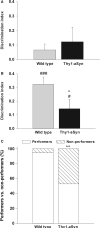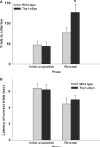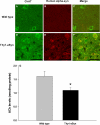Cognitive deficits in a mouse model of pre-manifest Parkinson's disease
- PMID: 22356593
- PMCID: PMC3967873
- DOI: 10.1111/j.1460-9568.2012.08012.x
Cognitive deficits in a mouse model of pre-manifest Parkinson's disease
Abstract
Early cognitive deficits are increasingly recognized in patients with Parkinson's disease (PD), and represent an unmet need for the treatment of PD. These early deficits have been difficult to model in mice, and their mechanisms are poorly understood. α-Synuclein is linked to both familial and sporadic forms of PD, and is believed to accumulate in brains of patients with PD before cell loss. Mice expressing human wild-type α-synuclein under the Thy1 promoter (Thy1-aSyn mice) exhibit broad overexpression of α-synuclein throughout the brain and dynamic alterations in dopamine release several months before striatal dopamine loss. We now show that these mice exhibit deficits in cholinergic systems involved in cognition, and cognitive deficits in domains affected in early PD. Together with an increase in extracellular dopamine and a decrease in cortical acetylcholine at 4-6 months of age, Thy1-aSyn mice made fewer spontaneous alternations in the Y-maze and showed deficits in tests of novel object recognition (NOR), object-place recognition, and operant reversal learning, as compared with age-matched wild-type littermates. These data indicate that cognitive impairments that resemble early PD manifestations are reproduced by α-synuclein overexpression in a murine genetic model of PD. With high power to detect drug effects, these anomalies provide a novel platform for testing improved treatments for these pervasive cognitive deficits.
© 2012 The Authors. European Journal of Neuroscience © 2012 Federation of European Neuroscience Societies and Blackwell Publishing Ltd.
Figures






Similar articles
-
Social Cognition Impairments in Mice Overexpressing Alpha-Synuclein Under the Thy1 Promoter, a Model of Pre-manifest Parkinson's Disease.J Parkinsons Dis. 2015;5(3):669-680. doi: 10.3233/JPD-140503. J Parkinsons Dis. 2015. PMID: 25588356 Free PMC article.
-
Vocalization deficits in mice over-expressing alpha-synuclein, a model of pre-manifest Parkinson's disease.Behav Neurosci. 2014 Apr;128(2):110-21. doi: 10.1037/a0035965. Behav Neurosci. 2014. PMID: 24773432 Free PMC article.
-
Olfactory deficits in mice overexpressing human wildtype alpha-synuclein.Eur J Neurosci. 2008 Jul;28(2):247-56. doi: 10.1111/j.1460-9568.2008.06346.x. Eur J Neurosci. 2008. PMID: 18702696 Free PMC article.
-
A progressive mouse model of Parkinson's disease: the Thy1-aSyn ("Line 61") mice.Neurotherapeutics. 2012 Apr;9(2):297-314. doi: 10.1007/s13311-012-0104-2. Neurotherapeutics. 2012. PMID: 22350713 Free PMC article. Review.
-
A Mouse Model to Test Novel Therapeutics for Parkinson's Disease: an Update on the Thy1-aSyn ("line 61") Mice.Neurotherapeutics. 2023 Jan;20(1):97-116. doi: 10.1007/s13311-022-01338-0. Epub 2023 Jan 30. Neurotherapeutics. 2023. PMID: 36715870 Free PMC article. Review.
Cited by
-
Role of rodent models in advancing precision medicine for Parkinson's disease.Handb Clin Neurol. 2023;193:3-16. doi: 10.1016/B978-0-323-85555-6.00002-3. Handb Clin Neurol. 2023. PMID: 36803818 Free PMC article. Review.
-
Behavioral defects associated with amygdala and cortical dysfunction in mice with seeded α-synuclein inclusions.Neurobiol Dis. 2020 Feb;134:104708. doi: 10.1016/j.nbd.2019.104708. Epub 2019 Dec 16. Neurobiol Dis. 2020. PMID: 31837424 Free PMC article.
-
The Effects of Different Feeding Routines on Welfare in Laboratory Mice.Front Vet Sci. 2020 Jan 14;6:479. doi: 10.3389/fvets.2019.00479. eCollection 2019. Front Vet Sci. 2020. PMID: 31993444 Free PMC article.
-
Toxin-Induced Experimental Models of Learning and Memory Impairment.Int J Mol Sci. 2016 Sep 1;17(9):1447. doi: 10.3390/ijms17091447. Int J Mol Sci. 2016. PMID: 27598124 Free PMC article. Review.
-
Novel AAV-based rat model of forebrain synucleinopathy shows extensive pathologies and progressive loss of cholinergic interneurons.PLoS One. 2014 Jul 7;9(7):e100869. doi: 10.1371/journal.pone.0100869. eCollection 2014. PLoS One. 2014. PMID: 24999658 Free PMC article.
References
-
- Aarsland D, Andersen K, Larsen JP, Lolk A, Nielsen H, Kragh-Sørensen P. Risk of dementia in Parkinson's disease: a community-based, prospective study. Neurology. 2001;56:730–736. - PubMed
-
- Beauchamp MH, Dagher A, Panisset M, Doyon J. Neural substrates of cognitive skill learning in Parkinson's disease. Brain Cogn. 2008;68:134–143. - PubMed
Publication types
MeSH terms
Substances
Grants and funding
LinkOut - more resources
Full Text Sources
Other Literature Sources
Medical
Molecular Biology Databases
Miscellaneous

